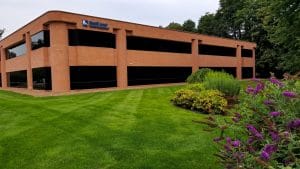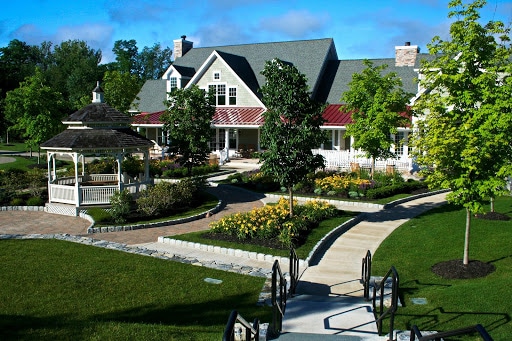 Is your lawn looking spotty? There are many reasons dead spots can develop in a lawn, from grubs to animal damage and fungal diseases. Not to mention, the heat stress our turfs face in midsummer can take a toll on grass and result in browned-out areas, some of which might need extra care to recover. Regardless of why your grass has dead, thinning or bare spots, we know it’s not exactly the look you were going for.
Is your lawn looking spotty? There are many reasons dead spots can develop in a lawn, from grubs to animal damage and fungal diseases. Not to mention, the heat stress our turfs face in midsummer can take a toll on grass and result in browned-out areas, some of which might need extra care to recover. Regardless of why your grass has dead, thinning or bare spots, we know it’s not exactly the look you were going for.
What can you do to fix the dead spots in your turf and reclaim your curb appeal?
First, we recommend a lawn analysis to identify whether there is an underlying issue that needs to be addressed. When you understand the reason why dead spots are cropping up on your grass, you can deal with the root of the problem (no pun intended). For example, if grubs are the culprit, you’ll want to treat the problem so you can prevent turf damage from spreading. Or, if the yard has bare spots because the grass is not getting enough sunlight, trees might need to be pruned. Soil compaction can also result in brown or dead spots in the turfs grass. Regularly aerating turf can promote oxygen, water and nutrient circulation in soil and prevent turf damage.
When it comes to fixing dead spots in your Connecticut, New York or New Jersey lawn, here are four steps a pro turf lawn service will take to encourage damaged spots to grow green again.
#1 Clear the Way—Remove Damaged Grass and Debris
 First, dead grass should be removed from the area. If an entire lawn needs to be overseeded because there is more unhealthy turf than grass that is thriving, a professional will pull dead and damaged turf and weeds away from the surface.
First, dead grass should be removed from the area. If an entire lawn needs to be overseeded because there is more unhealthy turf than grass that is thriving, a professional will pull dead and damaged turf and weeds away from the surface.
This material is then raked up and removed before adding new seed to the turf.
Tip: We recommend testing the soil to determine if it requires amendment with nutrients to create fertile ground for new turf growth.
#2 Cultivate Soil for a Healthy, Fresh Start
With knowledge of the soil pH and levels of nitrogen, potassium and phosphorus, a pro turf care lawn service might recommend soil amendments. After all, if you plant new grass on soil that lacks the nutrients to support new plant growth, you’ll end up with the same problem you started with—grass that won’t grow, or a patchy lawn. At this point, the soil should be cultivated, ideally churning up a couple of inches off soil to loosen up the ground. This way, new grass seed roots can penetrate the soil and access water, nutrients and oxygen.
#3 Seed and Protect the Bare Spot
Quality seed should be applied to the bare spot, and timing is key. Ideally, we plant grass in late summer through early fall when the weather conditions are less likely to stress out young plants.
Spring is also a safe time to plant new grass seed. The same timing rules apply to renovate an entire lawn.
After spreading seed, organic material can be applied to the surface to encourage healthy growth.
#4 Just Add Water—and Nutrients
New seed should be watered at least daily, and more frequently depending on weather conditions. Ideally, the top half-inch of soil should stay moist until the grass is 1 inch tall. At this point, watering can be tapered to every other day for the next several weeks. After new grass is established, new grassy areas can be watered one to two times per week. Adopting a consistent landscape maintenance program, including fertilization and weed control, will help new and existing grass thrive.
Should You Fix Bare Spots, Overseed or Reseed Grass?
If your grass has several dead or bare spots, you’ll probably want to attempt seeding just the damaged areas. Why sacrifice the rest of the area if it’s growing strong? On the other hand, if your grass has damage in large areas or it is thinning, overseeding can help thicken up the landscape and promote new, healthy grass growth. For extensive damage, reseeding can allow you to completely remove the old grass, restore poor soil quality on your entire property, level the ground, and start fresh with new seed and a lawn care program to keep grass healthy.
Prevent Lawn Stress with a Comprehensive Turf Care Program
Occasionally brown spots due to drought are common, especially in the heat of summer. But when your yard develops dead or bare spots—or if the entire turf is thinning out—it’s time to be proactive and restore those areas so they do not impact your turf’s overall health and appearance.
Not sure what to do about those dead spots in your yard? A free lawn analysis will uncover any issues, and we can come up with a plan to get your landscape back on track.
Contact us in Hudson Valley, 845-463-0592; Westchester, 914-271-7996; Connecticut, 203-212-4800; and New Jersey, 201-591-4570. Or, fill out our contact form and we’ll get in touch with you.